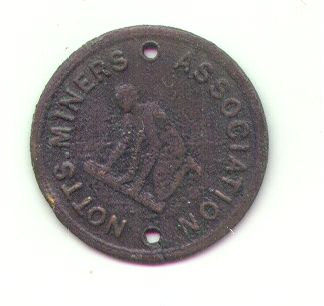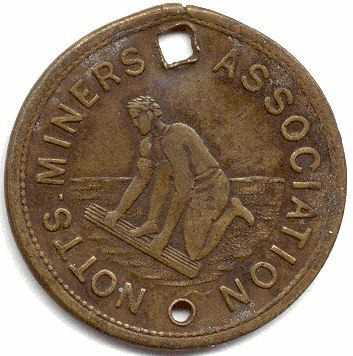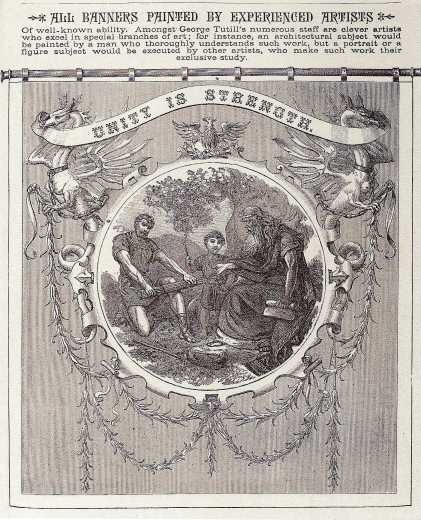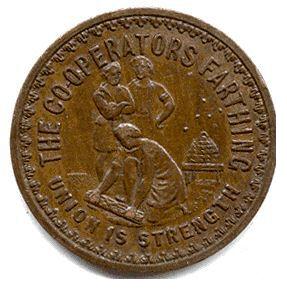
An Nottinghamshire Miners' Association Badge With A Very Puzzling Design.

An example of an N.M.A. membership badge depicting the enigmatic "kneeling miner" design (Actual size 32 mm dia.)
As a metal detectorist I have built-up a reference collection of nearly eighty different Nottinghamshire Miners' Association (N.M.A.) badges or checks. All of these I have found in the villages near to where I live in Nottinghamshire.
Several of the N.M.A. badge designs known feature typical symbols of fraternal solidarity and unity. Such symbols include shaking or clasped hands plus the lesser known image of an open palm holding a heart. Without a doubt the most puzzling of all the N.M.A. badge designs is that illustrated above. This is particular badge design is usually referred to by collectors as the "kneeling miner" type. It depicts the figure of a man kneeling and holding what could possibly be a pit prop. The significance behind this enigmatic badge design, which probably dates from the first quarter of the twentieth century, now appears lost.
Can anyone throw any light on exactly
what this badge depicts and what its significance may be in relation to the
N.M.A. or early mining trade unionism?

REPLY No.2
I recognise the symbolism of the bundle of sticks as being a well known
reference to the trade union doctoring of "unity is strength". The symbolism is
derived from one of Aesop's classical fables - "The Bundle of Sticks" which
recounts the following tale;
An old man on the point of death summoned his sons around him to give them some parting advice. He ordered his servants to bring in a faggot of sticks, and said to his eldest son: "Break it." The son strained and strained, but with all his efforts was unable to break the Bundle. The other sons also tried, but none of them was successful. "Untie the faggots," said the father, "and each of you take a stick." When they had done so, he called out to them: "Now, break," and each stick was easily broken. "You see my meaning," said their father. Union gives strength.
REPLY No.3
To further endorse the answer given in the above reply I can confirm that the symbol of the "bundle of sticks" was used on several miners' lodge banners in County Durham at least between the 1870s and 1930s. It was a common and favourite theme which appeared in the Tutill's (the famous union banner makers) design catalogues over this period and would have had a well known and instantly recognisable meaning to most union members and organisers of the period.

An standard trade union banner design taken from one of Tutill's catalogues depicting the "Bundle of Sticks" fable.
The following is taken from Norman Emery's book "Banners of the Durham Coalfield" under his discussion of standard and common banner theme designs;
"UNITY IS STRENGTH" - The bundle of
sticks image, commonly found on the reverse side of banners, is taken from
Aesop's 'Unity is Strength' fable.13 Although this Greek story was written
around the mid-sixth century BC, the banner illustration generally shows the
figures as Anglo-Saxons. A Germanic style chieftain is normally shown seated in
an elaborate chair or throne on the right side of the painting. He is usually
shown as either a venerable figure with a long beard, or a warrior, with his
sheathed sword lying close by him. In front of him, on the far left, a young man
dressed in a tunic and furs kneels and attempts to break a bundle of sticks over
his knee. Meanwhile, in the centre of the scene, a young boy is shown
triumphantly breaking a stick. Variations on the standard form are found. On the
Trimdon Grange banner, the small boy was dispensed with and the young Saxon
continued his attempts to break the bundle, while an old man, sitting on a step
and dressed in more Biblical costume, snaps one of the sticks. Butterknowle
updated the figures, showing the old man, in fact John Wilson, dressed in a
black frock coat, while the young man and boy are in work clothes. The fable's
symbolism of strength in union was reduced to its most basic form on an early
Tursdale banner, where a single workman is shown attempting to break the bundle
of sticks.
It sounds like the latter mentioned design for the DMA's Tursdale Lodge may have depicted a similar image to that on the well known NMA badge under discussion.
Submitted By :
John Gough.
Date: October 2005.
REPLY No.4
Out of interest I wander if the makers of the following WORCESTER CO-OPERATIVE SOCIETY LIMITED copper farthing token were also responsible for the manufacture of the NMA badge? The pose and style of the kneeling figures in these two pieces are strikingly similar to each other.

Obverse of a co-op farthing depicting the "Bundle of Sticks" fable together with motto "Unity Is Strength".
Submitted By : Mike Shaw.
Date: October 2005.